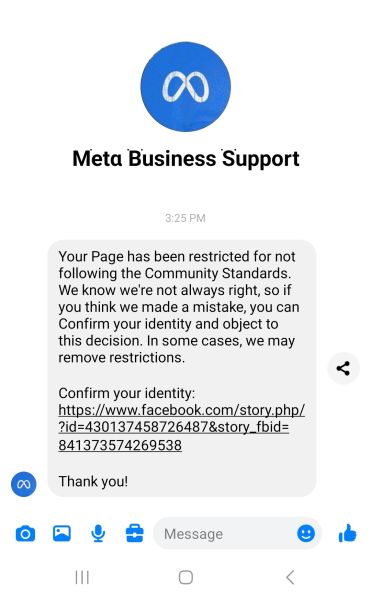I got a Facebook message saying my account is going to be suspended. Is it real?
Answered by a Professional Business Marketing and social media management company.

The Anatomy of the Scam:
The scam typically begins with a seemingly urgent message from an unknown sender, posing as an official representative from the social media platform. The message alleges that you’ve committed a violation, often vaguely described, and warns that your account is at risk of suspension. To add a sense of urgency, the message may include a threat that your account will be permanently disabled unless immediate action is taken.
Why It’s a Scam:
-
No Official Communication: Legitimate social media platforms do not initiate communication about account issues through unsolicited direct messages. Official communications are typically delivered through platform notifications or emails, not random private messages.
-
Generic Language: Scammers often use generic and non-specific language in an attempt to cast a wide net, catching unsuspecting users who may be concerned about the security of their accounts.
-
Urgency and Fear Tactics: Scammers exploit fear by creating a sense of urgency. They want you to act quickly without thinking, playing on the fear of losing access to your social media account.
What to do:
-
Simply Delete the Message: If you have not clicked on anything yet then your account is still secure as this is simply a message similar to a scam email. The scammers do not have access to your account. All you need to do is delete the message and block the sender.
How to Protect Yourself From Future Scams:
-
Verify the Sender: Before taking any action, verify the legitimacy of the sender. Check for official verification badges on the social media platform or visit the official support channels to confirm the message’s authenticity.
-
Avoid Clicking on Links: Scammers may include links that appear official but lead to phishing sites. Never click on suspicious links. Instead, navigate directly to the official website to log in and check your account status.
-
Contact Official Support Channels: If you receive a suspicious message, reach out to the official support channels of the social media platform. Do not use contact information provided in the message, as it may lead to scammers.
-
Enable Two-Factor Authentication (2FA): Adding an extra layer of security, such as enabling 2FA, can help protect your account from unauthorized access even if your password is compromised.
-
Stay informed: Stay informed about common scams and phishing techniques. Familiarize yourself with the typical communication methods used by legitimate platforms, making it easier to identify scams.